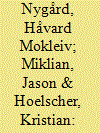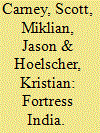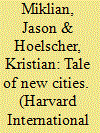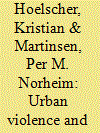|
|
|
Sort Order |
|
|
|
Items / Page
|
|
|
|
|
|
|
| Srl | Item |
| 1 |
ID:
153691


|
|
|
|
|
| Summary/Abstract |
What factors explain attacks on humanitarian aid workers? Most research has tended to describe trends rather than analyse the underlying reasons behind attacks. To move this agenda forward, we present to our knowledge the first peer-reviewed cross-national time-series study that identifies factors related to violent attacks on humanitarian aid workers. Our theoretical framework explores two sets of potential explanatory factors: dynamics of conflicts; and the politicization and militarization of humanitarian operations. Using a global sample at the country level from 1997 to 2014, our results suggest that: (i) the presence and severity of armed conflicts are related to increased attacks on aid workers; (ii) aid workers do not appear to face greater risks even where civilians are targeted; (iii) the presence of an international military force does not appear to add to nor decrease risks to aid workers; and (iv) the effects of peacekeeping operations upon humanitarian security are varied. We discuss this in light of the ongoing challenges facing humanitarian organizations to provide security in fragile and conflict-affected areas.
|
|
|
|
|
|
|
|
|
|
|
|
|
|
|
|
| 2 |
ID:
105088


|
|
|
|
|
| Publication |
2011.
|
| Summary/Abstract |
Felani wore her gold bridal jewelry as she crouched out of sight inside the squalid concrete building. The 15-year-old's father, Nurul Islam, peeked cautiously out the window and scanned the steel and barbed-wire fence that demarcates the border between India and Bangladesh. The fence was the last obstacle to Felani's wedding, arranged for a week later in her family's ancestral village just across the border in Bangladesh.
|
|
|
|
|
|
|
|
|
|
|
|
|
|
|
|
| 3 |
ID:
113938


|
|
|
|
|
| Publication |
2012.
|
| Summary/Abstract |
Why are some countries more prone to social violence than others? Despite the fact that annual deaths due to homicides worldwide outnumber those due to organized armed conflict by a factor of roughly 3 to 1, this question has received very little attention from conflict and development specialists in recent years. As a modest first step in addressing this gap in the literature we draw together insights from the conflict and criminology literatures to develop a model of social violence that accounts for both political-institutional and socio-economic factors. While there is an extensive literature on the socio-economic determinants of social violence, there are only a handful of studies that consider the significance of political-institutional arrangements. Using cross-country estimates of homicides produced by the World Health Organization as an indicator of social violence, we test our model using OLS regression analysis for a sample of more than 120 countries. We find that countries with 'hybrid' political orders experience higher rates of social violence than those with strong autocratic or strong democratic regimes, and that weakly institutionalized democracies are particularly violent. We also find robust associations between indicators of poverty, inequality and ethnic diversity and social violence. These results indicate that social and political violence share some common underlying causes. We conclude by suggesting that the apparent global decline in organized armed conflict and the concomitant rise in social violence in recent decades may be linked to world urbanization and the 'third wave' of democratization in the global South, although further research is required to confirm this hypothesis.
|
|
|
|
|
|
|
|
|
|
|
|
|
|
|
|
| 4 |
ID:
132532


|
|
|
|
|
| Publication |
2014.
|
| Summary/Abstract |
The global shift from rural to urban living will be the most important demographic transformation of the 21st century. All great shifts create the opportunity for great fortunes, especially for those with audacious visions who are positioned to capitalize on them. Indian industrialist Ajit Gulabchand runs Hindustan Construction Company (HCC), which is responsible for some of the country's most iconic infrastructure projects. In what might be the single biggest bet in the history of Indian real estate, Gulabchand has staked HCC's future - and his own family fortune - on a cluster of five planned cities perched along artificial fjords about four hours east of Mumbai. He calls it Lavasa. 300 million people are projected to move into India's already overcrowded cities over the next quarter-century. Lavasa is Gulabchand's US$6 billion dollar attempt to capitalize on this demographic shift - and turn a profit in the process. He even modeled Dasve, the first of Lavasa's five cities, after Portofino on the Italian Riviera. Lavasa's sales team speaks of a "stirring adventure", complete with French lessons and rock climbing, for the 300,000 residents that it hopes to attract. With Indian cities feeling increasingly like pressure cookers, Lavasa's promise of clean air, sidewalks, and personal space attracted huge investments.
|
|
|
|
|
|
|
|
|
|
|
|
|
|
|
|
| 5 |
ID:
134171


|
|
|
|
|
| Publication |
2014.
|
| Summary/Abstract |
Despite problems of violence domestically, Brazil has played a key leadership role as part of MINUSTAH peacekeeping operations in Haiti since 2004. This article addresses how Brazil's international military engagement is shaping domestic approaches to urban security, and what may be the implications of the use of military strategies, operations, and norms to address issues of public security in Brazilian cities. It is argued that current approaches toward urban security employing military-trained peacekeepers actually represent a continuation of old paradigms, yet these recent militarised approaches are likely evolving into newer and potentially more accountable forms by constraining indiscriminate use of force and establishing a positive state presence in marginal urban areas. As such, the article connects long-established issues of dealing with urban violence in Latin America with ongoing debates in the United States and beyond about post-counterinsurgency approaches to increasingly urban conflict settings. It reflects on potential lessons to be learned from the Latin American perspective, while showing also how these have changed over the last decade. The article concludes that despite the potential utility of force in some urban conflict settings, this approach could entail a normative shift towards legitimising forceful containment of violence, and hinder democratic consolidation in Brazil.
|
|
|
|
|
|
|
|
|
|
|
|
|
|
|
|
|
|
|
|
|